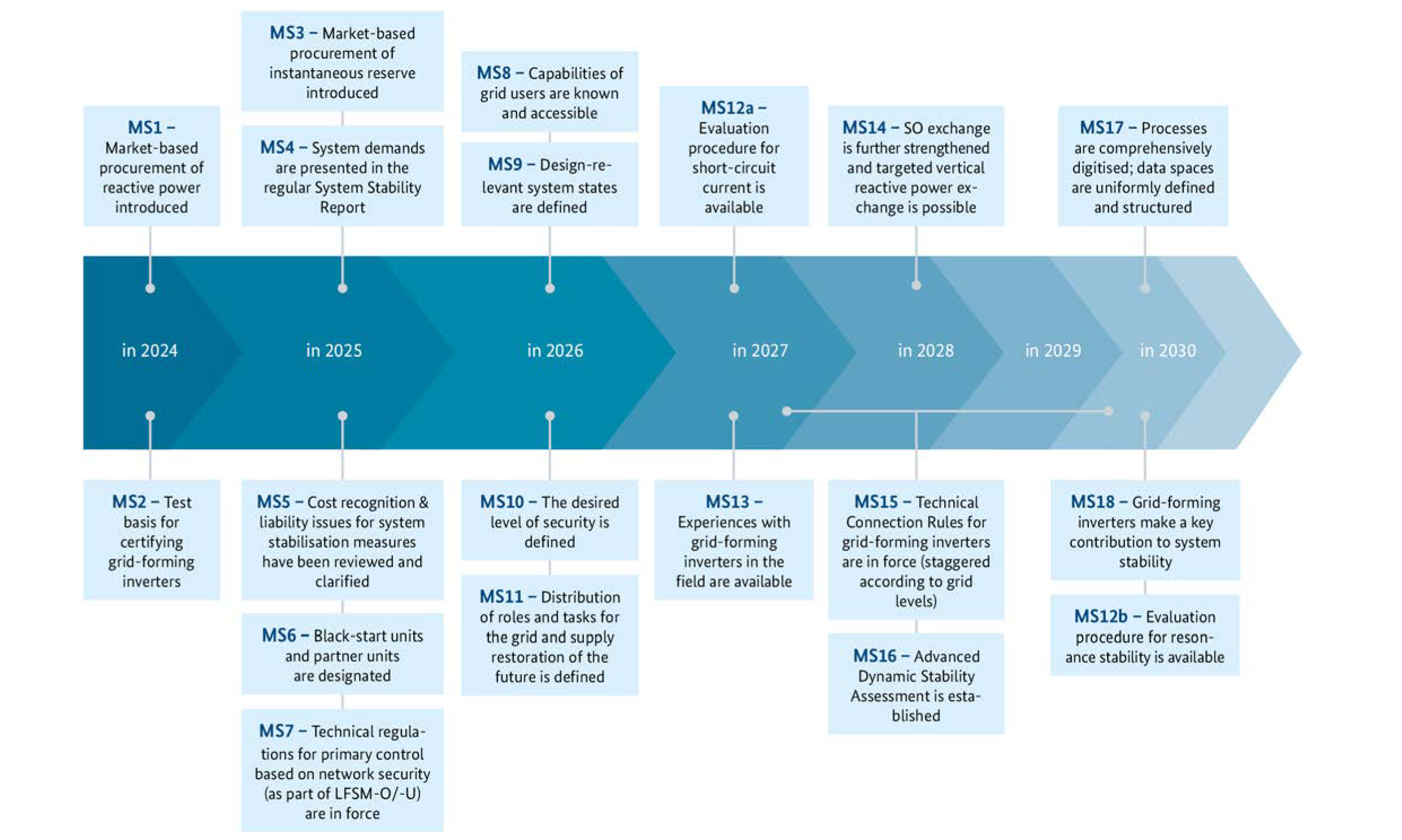The grid-forming technology as an essential part of the energy transition

Renewable energy can cover a growing energy demand. However, can it also ensure system stability when conventional power plants are increasingly being shut down? Large battery storage systems with grid-forming inverters play a key role here. What was previously performed by the inertia mass of the system generators in conventional power plants, is now managed by the power electronics of inverters in the increasingly renewable energy supply. Discover how these technologies contribute to the stabilization of the power grid and how the transition to a 100 percent renewable energy supply can be achieved.
Power plants generate energy and also provide grid-forming capability. In conventional power plants, synchronous machines with rotating inertia masses ensure grid stability by reacting to disturbances. This inertia ensures the grid operation and keeps the grid frequency stable. When these power plants are shut down, battery storage with grid-forming (GFM) inverters can provide these important stabilization functions.
Another important function for a reliable grid operation is also the grid restoration. The black-start function lets grid-forming inverters with battery storage energy systems start themselves and serve as a starting unit for the restoration of the utility grid after rare extreme events. The power electronics take on the tasks of the synchronous generators.
The importance of grid-forming inverters
In contrast to the centrally controlled conventional power plants, inverters do not have rotating masses, but the grid-stabilizing functions are programmed using control algorithms. The power electronics of the inverter therefore play a decisive role here.
The hardware can look the same or similar, while the software enables different functionalities in addition to the normal system functions depending on needs and requirements. A battery can then be used as energy storage to shift the stored energy from midday to the evening. But it is also ready at any time to absorb power peaks in order to keep the frequency stable. Large-scale battery storage power stations in the high and extra-high voltage ranges are already providing stability services.
Battery storage power stations address the two major challenges of the transformation of the energy system: grid stabilization and relieving the strain on the utility grid.
In this video, you will learn how grid forming works:
Best practices: UK is a pioneer in grid forming
The United Kingdom is currently a pioneer in new grid services, in particular for inertia and short-circuit levels.
The country has set itself the goal to achieve climate neutrality by 2050. To accomplish this goal, the country plans on supplying itself with fully carbon-free electricity (net zero) by 2035. For this purpose, the National Grid Electricity System Operator (NGESO) started numerous programs, which include the “Stability Pathfinder” program. Within this framework, the first projects implemented have been large-scale battery storage energy systems which provide stability services based on grid-forming inverters. This will keep the British utility grid stable and reliable, even as renewable power increases.
The contracts of the “Stability Pathfinder” program are the first ones worldwide regarding the provision of the grid services inertia and short-circuit levels. They aim to reduce fossil energy imports as well as allowing for additional renewable energy sources and increased efficiency. In this way, UK strengthens its energy independence, helps lower consumers electricity bills and contributes to a significant reduction in large amounts of CO2 emissions.
Case study: Blackhillock in Scotland gives go-ahead for inertia

A total of ten systems were tasked with providing stability services for the “Stability Pathfinder” program, five of which rely on large-scale battery storage power stations. At various locations in Scotland, grid-forming inverters will soon be connected to the utility grid for the first time.
The company Zenobé secured three “Stability Contracts” as part of the tender process. This includes the locations Blackhillock (200 MW/400 MWh), Kilmarnock South (300 MW/600 MWh) and Eccles (400 MW/800 MWh). To implement the first of these two projects, Zenobé relied upon SMA Grid Forming Solution.
SMA supplies the battery inverters with medium-voltage stations which the company Wärtsilä integrates into battery storage energy systems (BESS).
In Blackhillock, Scotland, the construction work began in February 2023. The completion is set for 2024. By bundling several income sources from day-ahead and intraday markets, control energy in combination with stability services and black-start capability, the competitiveness of the individual services increases. Consequently, the power and energy range of battery energy storage systems is utilized to the maximum.
Further information can be found at the following links:
- NOA Stability Pathfinder | ESO (nationalgrideso.com)
- Zenobē breaks ground on pioneering 300MW battery in Blackhillock – Zenobē (zenobe.com)
Comparable markets are emerging in the EU based on the new “non-frequency-based grid services”-these are currently implemented at a national level. In Germany, the market design is expected to be adopted this year –in 2024-, making it the first continental European market for inertia (see info box “Roadmap System Stability”).
There are other markets with locally weak utility grids, for example, in Australia. Tenders for inertia are also in place there, but often regionally limited. If an area is especially suitable due to its local conditions for building regenerative generating systems, but the transmission capacities are insufficient, grid-forming inverters with battery energy storage system can perform a dual function: they keep the voltage stable and, at the same time, flexibly move energy to the evening or nighttime hours, for example.
This will be increasingly the case in Europe when the utility grids are under high load, but grid expansion cannot keep up. Project developers are faced with the challenge of using the surfaces as best as possible on one hand while relieving the strain on the grid on the other. What matters now is to develop investment incentives and suitable business models.
The next level of the energy transition
In large battery storage power stations individual functions can be flexibly designed in terms of time using grid-forming inverters. Then it can be assessed whether to attach more weight to the energy trade or stabilization functions.
Operators of these battery storage power stations can benefit from three different options here:
- Energy transition: offers investment security
- Tenders for stability services: investment security through long-term contracts
- Grid restoration as grid service > make existing grid connections usable, strengthen the utility grids locally and counteract delayed grid expansion
Advantages for market players:
- Grid stability at low cost
- Cost-effective and climate-friendly energy on the market
Today, battery energy storage systems with grid-forming inverters are already able to compensate for short-term generation deficits, and provide grid services, such as reactive power, short-circuit levels, islanding and black-start capacity as well as inertia. The demonstration project of the public utility company Versorgungsbetriebe Bordesholm and the Cologne University of Applied Sciences proved that battery energy storage systems with grid-forming inverters are able to perform the grid stabilization tasks.
Demonstration project Bordesholm: 100 percent renewable energy supply possible.

In late 2019, the project partners simulated a large-scale power outage. They disconnected all households, businesses and institutions in Bordesholm from the European utility grid for an hour and, at the same time, activated a battery-backup grid. This stand-alone grid supplied the connected households and businesses with 100 percent renewable energies during this time. Therefore, the experiment went unnoticed by most of the 8,000 households.
“With this pilot project, we were able to show that it is possible to operate a complete utility grid with renewable energies and a battery to support the utility grid. The Bordesholm stand-alone grid is proof that entire regions can supply themselves with renewable energies.”
Prof. Dr. Eberhard Waffenschmidt from the Cologne University of Applied Sciences
We have documented this pilot project for you in a video.
Conclusion and outlook
The increasing digitalization and automatization of energy management allows for more room to continue improving the options for stabilizing the utility grid. Practical examples such as the project in Bordesholm show that entire regions can already be supplied reliably with renewable energies and battery storage today.
With the “Stability Pathfinder” program, Britain is looking to renewable energies and greater energy independence and is creating the appropriate economic incentives.
These projects already provide valuable findings and serve as a model for the transformation of the power system. They prove: Battery energy storage systems with grid-forming inverters set the course for system stability and a reliable electricity supply with 100 percent renewable energy.
What is needed now is close cooperation and open exchange between political decision-makers, grid operators, electric utility companies and relevant industry players. In terms of the energy transition, it is important to further accelerate technological progress, solve technical challenges and remove legal and regulatory hurdles.



Feel free to contribute!